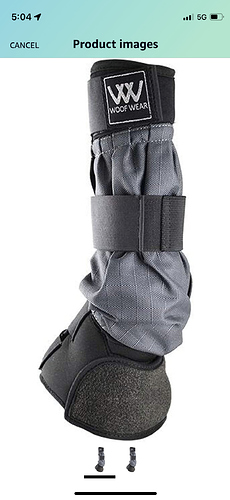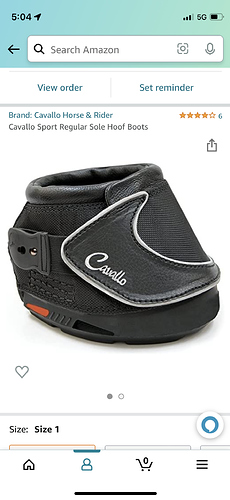Has anyone ever used the rubber waterproof hoof boots with the waterproof turnout boots to try and keep your horses hooves dry in the wet season?
I’ve never seen these.
Do you think it could work?!
Can you link to the boots you have in mind? Offhand I’ve never seen or heard of such a thing in hoof care groups. It could cause more problems than it solves. I don’t know of anything waterproof other than a Davis soaker boot 
My pony gets super tender feet in the wet season and can’t keep her locked up for a week at a time so I was looking at using these 2 products to help her keep dry and comfortable.
the Hoofwear boot is the Mud Fever boot meant to keep legs and pasterns out of the sun, and dry-ish. They don’t do anything to keep the feet dry.
The Cavallo boot will keep feet dryER, but they still allow moisture, if for no other reason than the hoof’s own moisture being trapped in there - I’ve used them.
A boot like the Cavallo can help protect the wet foot from hitting harder things that can cause bruising and abscessing, but they won’t keep the foot dry. You’d have to wrap the foot, using duct tape as the top layer, and then use a boot like the Cavallo, and that’s not healthy for the foot either.
What exactly does “gets super tender” mean? Does she have thin soles that simply can’t be soft? Shod or barefoot?
No product I know of will keep the feet dry. The problem is that hooves ‘sweat’, so even if you put them in a sealed bag, they will still stay moist and steamy. Also, it’s impressive how much heat hooves give off, so not only are you going to keep them moist you are also going to be keeping them warm… which makes the hooves softer.
I have used the cavallo boots when I needed to keep the hooves mud free because of thrush. But they still stay moist.
Would painting the feet w Keratex help?
Unless you thorough seal all aspects of the foot, soles, frog, white line, water line outer hoof wall, then moisture from the ground will work its way into the foot to some degree. And that wouldn’t be healthy anyway.
The healthier option is providing the protection the foot needs when it’s too soft due to all the moisture.
She is barefoot, she gets thrush easily and will not want to walk
What proper protection is your favorite option?
I’ve never heard of this, I’ll look into it
Not JB, but my first questions on a horse that is consistently getting thrush are: what is their stall like? And what is their farrier job like? Most thrush I’ve seen is from damp, dirty stalls or poor trims that create overgrown bars/frogs. The stall may look clean, but if the floor is damp it can be a real problem. Dirt floors and mats are particularly challenging.
This isn’t normal. IME, thrush-prone feet aren’t trimmed well, and/or the horse has uncontrolled insulin resistance or Cushing’s.
Healthy feet, on healthy horses, don’t get thrush simply because of a wet enviroment. If that were the case a great many horses in the SE would have thrush every Winter.
an you post a good side view, and solar view of one foot, as well as a conformation-type picture?
We are in the PNW. It’s wet and mild 8 or 9 months of the year. I’ve never had a horse barefoot or shod get thrush including in a stall, a runout, or a muddy wet field. The horses I’ve observed with thrush had issues with trim and with nutrition.
I’d suggest going over to the Pete Ramey website for barefoot hoof care and taking a look at the thrush protocol there for nutrition (copper, zinc, biotin), trimming (no crushed or contracted heels), and treatment (various including an antibiotic mix).
Thrush is not caused by wet. It’s a fungal or yeasty infection that can become quite deep seated. During the healing process it is useful to be able to get them into a clean dry area or stall, at least overnight. But dry alone will not cure it.
Do you think these products could help?
Cavallo Hoof Boots are not waterproof in the slightest. They have vents on the sides. I had a full set for a Miniature I had that a farrier had maimed.
Honestly, living in an area with a very wet winter/spring conditions with barefoot horses, I’ve had the best luck doing the following:
Hosing down when they come in.
Picking and treating 4-7 days a week with thrush medication (Tomorrow, No Thrush, or ACV).
Stalling in a heavily bedded stall for a least a few hours daily to allow their feet to dry out (always after hose down and treatment).
Using Keratex Hoof Hardener according to directions, on both the outer hoof wall, and the sole. I’ve also used it on my horses with soft frogs with phenomenal results.
Make sure you’re not using any hoof oils or conditioners right now. You don’t want to add more moisture to the foot. Make sure their trims are on a good schedule for the horse. My horses are trimmed every 4 weeks. That’s what works best for them, so that’s what we do.
I just bought some Kevlar hoof dressing that is pretty resilient and puts a nice shine on the hoof
As to the original question of how to keep the hooves dry - I have kept my horses hooves exceptionally dry under vet instructions by: stalling her during ANY rain or precipitation, stalling her when the dry lot/ paddock is muddier deeper than 1-2 inches, stalling her for at least an hour a day to take her hoof boots off and let the hooves and boots air out, keeping her stall heavily bedded (6+ inches of sawdust which is picked several times a day when she is in), using hoof boots with hoof powder (Benonite clay and zinc powder) when turned out and occasionally using a mens athletic sock over the hooves under the sock to absorb moisture (obviously the sock was changed every day). Is it easy? No. But the hooves are dry.
Now for the thrush - that is not normal. It could be the diet, the trim, or both. More info here would help.


